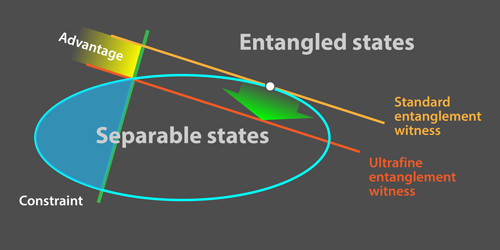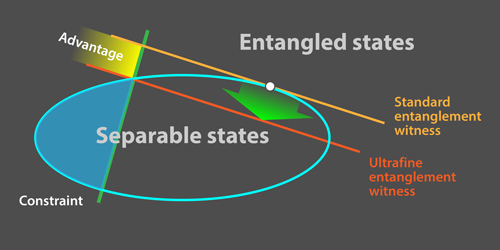Prepping an Entanglement Witness
Many quantum information applications require the sharing of entangled particles. Verifying this entanglement can be done with an “entanglement witness,” which is a set of measurements on the particles whose combined value falls under some bound when the particles are entangled. Farid Shahandeh and colleagues from the University of Queensland, Australia, show how to optimize entanglement witnessing with a new protocol that can detect more entangled states using fewer measurements than previous methods.
Entanglement witnessing is based on a division of a system’s possible quantum states into two subsets: an enclosed “island” of nonentangled (separable) states surrounded by a region of entangled states. In two dimensions, this division looks like a Venn diagram, with a single loop segregating the nonentangled and entangled regions.
An entanglement witness is basically a set of measurements on the system that divides this Venn diagram along some straight line. States on one side of this line give positive measured values, whereas states on the other give negative values. By carefully choosing the measurements, one can ensure that the whole nonentangled island is on the positive side of the line. Therefore, measuring a negative value implies entanglement (but some entangled states will return positive values).
The new protocol from Shahandeh and colleagues, called ultrafine entanglement witnessing, takes available but unused measurement data from the standard procedure to effectively eliminate portions of the nonentangled island from consideration. This elimination allows the entanglement witness line to be redrawn so that more of the entangled-state region is identified. The team’s procedure relaxes certain constraints on the witnessing measurements, so that the experimental setup for verifying entanglement can be made simpler than in the standard case.
This research is published in Physical Review Letters.
–Michael Schirber
Michael Schirber is a Corresponding Editor for Physics based in Lyon, France.





